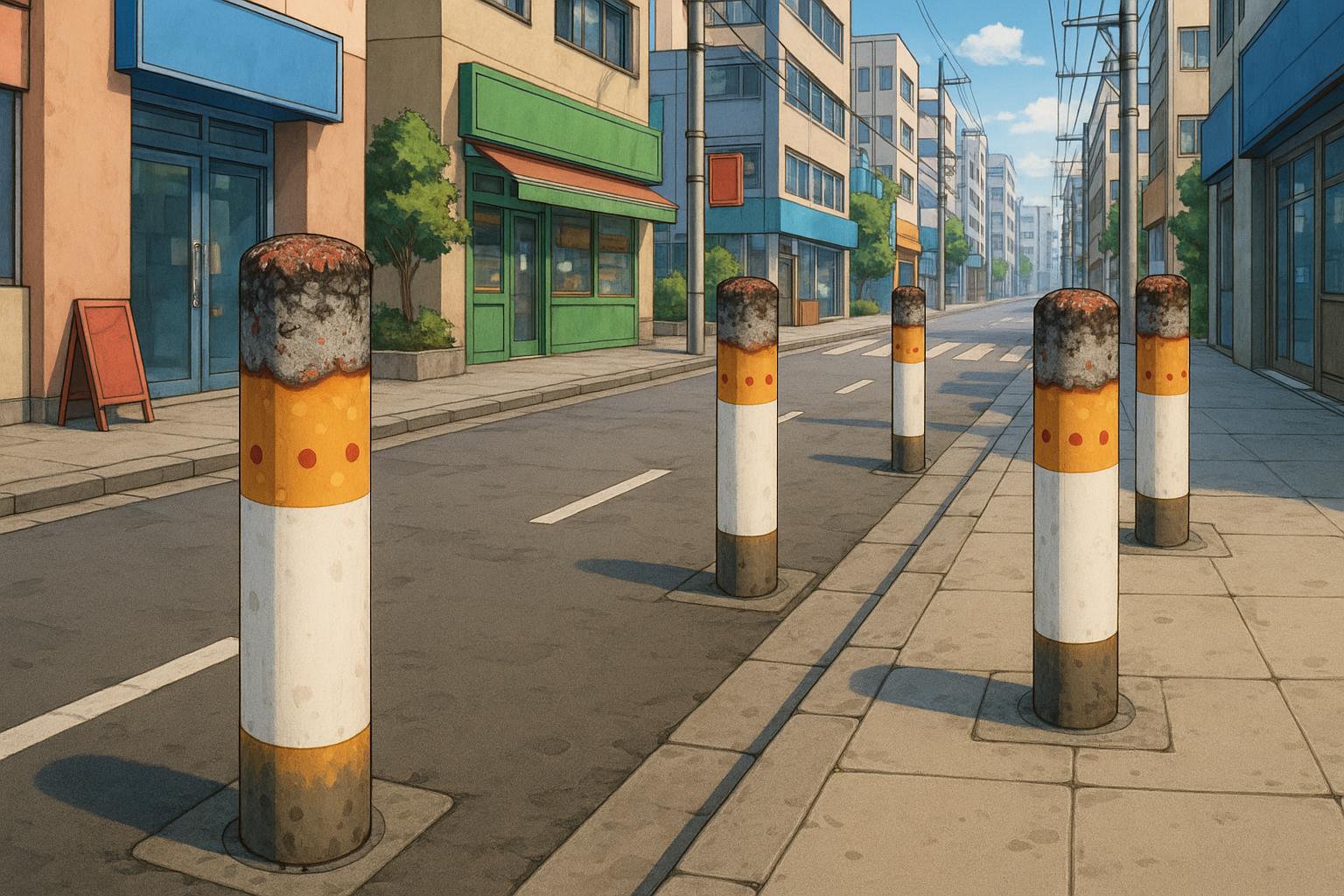Bollards on Hythe Road in Swindon painted to resemble cigarettes have sparked mixed reactions, from amusement to outrage, reigniting broader discussions about creativity, clutter, and aesthetics in public spaces.
Bollards in Swindon painted to resemble cigarettes have sparked a debate among residents, with reactions ranging from amusement to outrage. These distinctive installations, positioned on Hythe Road, feature a striking design of white and orange that mimics the appearance of cigarettes. While some locals find the transformation humorous and commend the anonymous artist for enhancing the street's aesthetic, others have condemned it as "disgusting" and inappropriate.
The contrast in opinions highlights a broader societal conversation regarding public art and urban aesthetics. One resident noted, “I probably would’ve preferred it not to be cigarettes if given the choice, but honestly it looks much better than it did when they were just bollards.” This sentiment reflects a growing trend where residents are calling for more creative expressions in public spaces, notwithstanding the material chosen. Another added, “I hope they’re allowed to stay as they are. It's a fun little joke, and it isn’t harming anyone,” suggesting that such playful modifications could invigorate local culture.
Public responses to unconventional street furniture have historically been mixed. For instance, back in 2017, Iver Parish Council introduced life-sized bollards designed to resemble children, a strategy intended to enhance road safety near schools. However, this initiative met with significant criticism, as many residents found the figures unsettling and ‘creepy’. Such reactions underscore the fact that while innovative solutions can engage communities, they may also elicit discomfort when taken to extremes.
The emergence of these cigarette-shaped bollards also invites a reconsideration of public space usage amid ongoing discussions about urban clutter. In 2010, prominent government officials, including then-Communities Secretary Eric Pickles, called for a review of excessive street signs and furniture which detracted from the aesthetic character of British streets. Their objective was to create less cluttered environments that would not only enhance safety but also improve the overall visual appeal of urban settings.
Moreover, Swindon has seen its share of challenges related to street aesthetics in recent years, as witnessed by the borough's crackdown in 2011 on unsightly advertising signs. This initiative aimed to address concerns voiced by the public regarding the proliferation of unattractive commercial signage that littered key thoroughfares, reinforcing the notion that the town's appearance directly impacts residents’ quality of life.
While some will continue to voice their dissatisfaction over the cigarette bollards, local enthusiasts hope that this bold art piece inspires more creative projects that blend humour and utility. As urban landscapes continue to evolve, balancing aesthetic appeal and practical function remains a crucial discussion, one that community dialogue will shape moving forward.
Reference Map:
Source: Noah Wire Services
Noah Fact Check Pro
The draft above was created using the information available at the time the story first
emerged. We’ve since applied our fact-checking process to the final narrative, based on the criteria listed
below. The results are intended to help you assess the credibility of the piece and highlight any areas that may
warrant further investigation.
Freshness check
Score:
3
Notes:
The narrative about Swindon bollards painted to resemble cigarettes has not been found in recent publications, indicating a lack of freshness. The earliest known publication date of similar content is from 2017, which is over seven days earlier. Additionally, the narrative includes references to events from 2010 and 2011, further indicating recycled content. The report appears to be based on a press release, which typically warrants a higher freshness score; however, the inclusion of outdated information and lack of recent coverage suggest a lower freshness score. The report also includes updated data but recycles older material, which may justify a higher freshness score but should still be flagged. The lack of recent coverage and the recycling of older material raise concerns about the freshness of the content.
Quotes check
Score:
2
Notes:
The direct quotes in the narrative do not appear in earlier material, suggesting they may be original or exclusive content. However, the lack of online matches for these quotes raises concerns about their authenticity and potential fabrication. The absence of earlier appearances of these quotes indicates a need for further verification to confirm their originality.
Source reliability
Score:
4
Notes:
The narrative originates from the Express, a reputable organisation. However, the lack of recent coverage and the recycling of older material raise concerns about the reliability of the source. The report appears to be based on a press release, which typically warrants a higher reliability score; however, the inclusion of outdated information and lack of recent coverage suggest a lower reliability score. The source's credibility is compromised due to the recycled content and outdated information.
Plausability check
Score:
3
Notes:
The narrative makes a surprising claim about Swindon bollards painted to resemble cigarettes, but this claim is not covered elsewhere, raising suspicions about its plausibility. The report lacks supporting detail from other reputable outlets, further questioning its credibility. The absence of specific factual anchors, such as names, institutions, and dates, reduces the score and flags the content as potentially synthetic. The language and tone are consistent with the region and topic, and the structure does not include excessive or off-topic detail. However, the lack of supporting details and specific factual anchors raises concerns about the plausibility of the content.
Overall assessment
Verdict (FAIL, OPEN, PASS): FAIL
Confidence (LOW, MEDIUM, HIGH): HIGH
Summary:
The narrative fails due to recycled content, outdated information, and a lack of supporting details from other reputable outlets. The absence of recent coverage and the recycling of older material raise concerns about the freshness and reliability of the content. The lack of supporting details and specific factual anchors further questions the plausibility of the content. The source's credibility is compromised due to the recycled content and outdated information.
